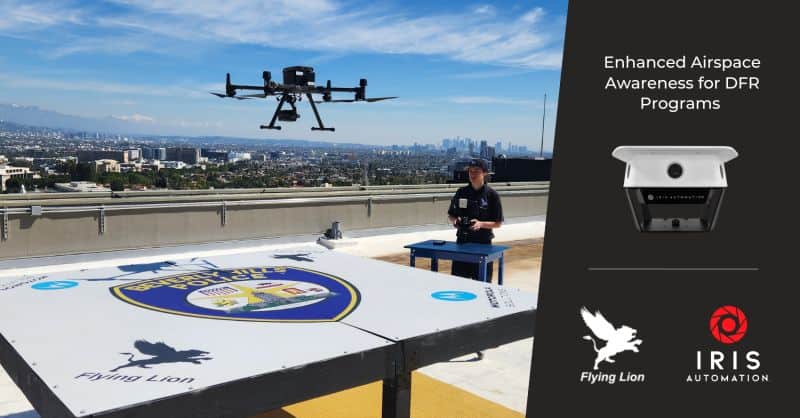



Iris Automation has entered into a new partnership with drone service provider Flying Lion, Inc. to provide Drone as First Responder (DFR) programs with enhanced airspace awareness.
This partnership will see the addition of Iris Automation’s Casia G ground-based detect and alert system to the Flying Lion suite of services.
With over 22,000 DFR flights logged to date, Flying Lion has vast experience working closely with leading law enforcement agencies to provide rapid emergency response and aerial assessment through DFR programs, including for Chula Vista PD, Redondo Beach PD, Santa Monica PD, and Beverly Hills PD.
In order to comply with current FAA requirements, Flying Lion and these DFR programs have been utilizing human Remote Pilots In Command (RPICs) and Visual Observers (VOs) to allow for BVLOS operations in their cities.
While this has been necessary to comply with FAA Certificate of Authorizations (COAs) for these agencies, it is not optimal for ongoing or large-scale DFR operations. DFR programs enable the immediate dispatch of a drone in response to a 911 call for the purpose of real-time aerial situational awareness, in advance of, and to support ground units to enhance community and first responder safety.
Iris Automation believes that with the implementation of Casia G, the next generation of DFR programs will have the capability to create a volume of surveilled airspace to conduct drone operations without the need for human visual observers.
Casia G is a small, passive, low-power, weather-hardened device that can be installed anywhere there is a clear view of the sky. This can be a rooftop, street light pole, cellular tower, or other vertical structure. Casia G detects cooperative aircraft using ADS-B and non-cooperative aircraft using Iris’ patented computer vision and artificial intelligence software. Once an aircraft is detected, two concepts of operation are possible:
- Casia G alerts the RPIC, providing the classification and location of the detected aircraft. The RPIC then initiates an avoidance maneuver and resumes the mission once the detected aircraft is clear of the operational area.
- Casia G sends an automated collision alert to the uncrewed aerial system’s command software, resulting in the system automatically executing a pre-programmed avoidance maneuver.
“Flying Lion is proud to partner with such a forward-thinking organization as Iris Automation, to provide a safer environment to conduct DFR operations,” said Flying Lion President & Founder, Barry Brennan. “The Casia G technology for BVLOS drone flights breaks new ground for public safety – it not only saves time and resources but also allows first responders to better protect the communities they serve.”
Multiple Casia G nodes can be deployed to cover any operational area, enabling drones to cover an entire municipality. DFR program managers can then enjoy BVLOS operations of multiple UAS from multiple launch points, enabling minimum response time. In addition, the ability to fly routine BVLOS missions enables the centralized management and operations of the UAS, and integration into 911 dispatch and real-time crime center operations.
There are more than 18,000 municipal police departments in the USA, and only 200 of them have access to an aerial asset. BVLOS operation of drones enables the remaining 17,800 departments to not only have access to an aerial asset, but within existing budget constraints – relieving pressure on the human capital in police operations.
“Casia G provides an inexpensive and effective way for customers to take advantage of BVLOS flight through increased airspace awareness without the use of visual observers,” said Iris Automation CEO, Jon Damush. “The new types of DFR programs are a perfect example, and working with Flying Lion and its incredible work across law enforcement to offer these solutions is an important step.”





Related Posts
New Drone Fires Thales Missile in Unmanned Air Combat Milestone
UAS Startup Accelerator Awards 3M in Funding
US Navy Orders Unmanned Tactical Resupply Aircraft